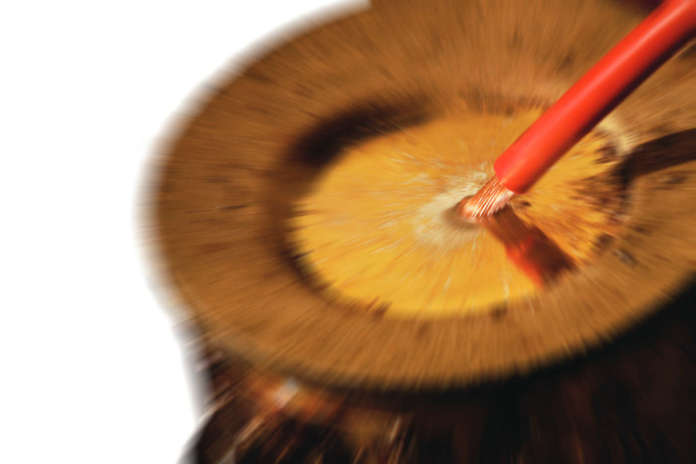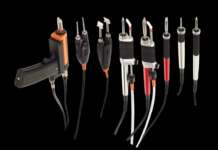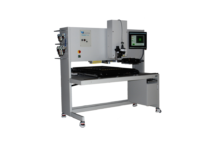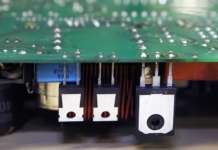The temperature of the molten alloy significantly affects the wetting time of the joints and the stability of the wave. Keeping the well temperature under control therefore helps to control the wave soldering process.
According to IPC/JEDEC1 (www.ipc.org) the crucible temperature should be set between 230 and 260°C for tin-lead alloys and between 260 and 290°C for lead-free alloys.
Due to the higher melting point of lead-free alloys, the higher temperature of the solder pot improves solderability and reduces contact times. For AgSnCu, with a melting point of 217 °C, some alloy manufacturers recommend the crucible temperature should be set between 250 and 270°C. For the SnCu alloy with a melting point of 227 °C, the crucible should be brought to 260-280 °C.
Two instruments are the most suitable for this, the IR thermometer and the thermometer with PT100 probe. The first is for non-contact measurements and the second for immersion probe measurements.
IR thermometer (capture the temperature from the thermal radiation)
An infrared thermometer deduces temperature from the thermal radiation emitted by the measured object.
Being a device for measuring temperature from a certain distance, a laser is used to help direct the instrument at the point to be measured. This usually projects a visible red dot in the center of the area to be measured, which identifies the point to be measured, but has no active role in the measurement.
A non-contact infrared thermometer is useful for measuring temperature in circumstances where it is not possible or desirable to use other types of sensors such as probe sensors.
The instrument essentially consists of a lens to focus the IR radiation onto a detector, which converts the radiating power into an electrical signal. This is then processed and displayed in temperature units (°C or °F), after ambient temperature being has been taken into account.
Simpler (and less expensive) instruments can have a measurement error of approximately ± 2 °C or ± 4 °F.
The distance-to-point ratio is the ratio of the distance from the measurement surface to the diameter of the temperature measurement area. For example, if the ratio is 12: 1, the diameter of the measurement area is one twelfth of the distance to the object. A thermometre with a high distance-to-point ratio can detect a more specific (narrower) surface at a greater distance than one with a smaller ratio.
To ensure an accurate non-contact temperature measurement, the following variables should be considered:
Optical resolution - the optical system of an infrared sensor collects IR energy from a circular measuring point and focusses it on the detector. The optical resolution is defined by the relationship between the distance between the instrument and the object, in relation to the size of the measured point (given as D: S from the English distance to spot size ratio). The larger the ratio number, the better the resolution of the instrument and the smaller the spot size that can be measured from a greater distance.
Field-of-View - before proceeding with the measurement make sure that the target is larger than the size of the point measured by the instrument (spot). The smaller the target, the closer the measurement is to be made. When accuracy is critical, make sure the target is at least twice the size of the spot.
Environmental conditions - the environmental conditions in the area where the measurement is to be carried out must be considered; steam, dust, smoke, vibrations etc. can prevent an accurate measurement.
Emissivity - emissivity is a measure of an object's ability to emit infrared energy. The energy emitted is indicative of the temperature of the object. The emissivity can have a value between 0 (glossy mirror) and 1.0 (black body).
The Fluke 64 MAX infrared thermometer (distributed by Distek) has a measuring range of -30°C to 600°C, with an accuracy of ± 1°C for measuring temperatures above 0°C. The emissivity ranges from 0.1 to 1, and the optical resolution (D: S) is 20: 1.
These features make it the right tool for non-contact measurement of the molten alloy temperature. Setting the time and desired interval between measurements with the automatic acquisition function allows you to automatically detect the temperature. It also displays the minimum, maximum or average temperature, or the difference between two measurements, allowing the recording of 99 data. Alarms for exceeding the minimum and maximum thresholds enable quick display of the measurements that do not fall within the set limits.
RTD HD2307 Thermometer
The HD2307.0 RTD or Resistance Temperature Detector, (produced by Delta OHM and distributed by Distek) is a portable instrument used to detect temperature values in different contexts using immersion, penetration, contact or air. It features an LCD display to view measurements in degrees Celsius or degrees Fahrenheit.
With this instrument it is possible to detect the maximum, minimum and average values of the measurements to be taken, using the MAX, MIN and AVG function, respectively.
Other available functions are: the relative measurement REL, the HOLD function and automatic switching off, which can be excluded.
The instrument works with temperature probes equipped with SICRAM module (with platinum Pt100 sensor), or with direct 4-wire Pt100, 3-wire Pt100, or 2-wire Pt1000 sensor. The excitation current is chosen in such a way as to minimize the self-heating effects of the sensor. The advantage of the SICRAM module is to act as an interface between the sensor, placed in the probe, and the instrument: a circuit with memory allows the instrument to recognize the type of probe connected and to read its operating data. In addition, this automatic recognition module ensures that the probes inside them have stored the factory calibration data.
With the crucible of the wave welder, the immersion probe is used. The immersion temperature measurement is performed by introducing the probe into the liquid in which the temperature measurement is to be performed by at least 60 mm; the sensor is housed in the terminal part of the probe. To obtain maximum accuracy in measurement, the recommended probes are TP472I and TP472I.O. With a response time of 3 seconds, they ensure an accuracy of ± 0.2 ° C, up to 250 ° C and ± 0.3 ° C above 250 ° C. The measuring range varies from -50 ° C to +300 ° C of the TP472I.O probe to -196 / + 500 ° C of the TP472I. The stem of both has a diameter of 3 mm and is 230 mm (TP472I.O) or 300 mm (TP472I) long, handle excluded. The probes have a 2 meter cable for connection to the instrument.
Generalities regarding Pt100 probes
The Pt100 probe is a platinum resistance thermometer with a nominal resistance of 100 Ω at a temperature of 0 ° C (according to the IEC 751 standard); it has been used for many years to measure temperatures in the laboratory or in industrial applications. There are also other RTD (Resistance Temperature Detector) sensors such as resistance thermometers like the Pt1000.
These components are thermoresistant, i.e. they are sensors with temperature and electrical resistance in close connection where, as one measurement varies, the other also varies. As they have a positive coefficient, the resistive value also increases as the temperature increases.
Platinum resistance thermometers are used for their robustness and their insensitivity to electrical interference. Compared to other Pt100 temperature detectors, they have the following advantages:
- Wide temperature range, from -200 ° C to +850 ° C
- Almost linear response curve
- Excellent accuracy
- High and durable stability
- The Pt100 sensors are made in two technologies: wire wound and thin film.
Wire-wound sensors consist of a thin platinum wire wrapped around a ceramic or glass core. Thin film ones are made with the same technologies used in electronics; a platinum film is deposited on a ceramic substrate which is then be encapsulated. The diameter varies from 1 to 5 mm for 10-50 mm in length.
The temperature measurement is performed as a function of the resistance assumed by the sensor, but other unwanted resistances may be present due to the connection conductors and connections.
These resistive values, although minimal, could cause measurement errors. To overcome this problem and compensate for unwanted resistances, the resistance thermometer can be connected to the measuring circuit of the instrument through a connection that uses two, three or four wires. The way to have a measurement as accurate as possible is to use the PT100 with a four-wire connection. With the use of this type of connection, the influence of the wiring decreases, and it does not affect the accuracy of the measurement. The use of the four-wire connection is based on an operational amplifier in a differential configuration that favours a rapid and precise response.





